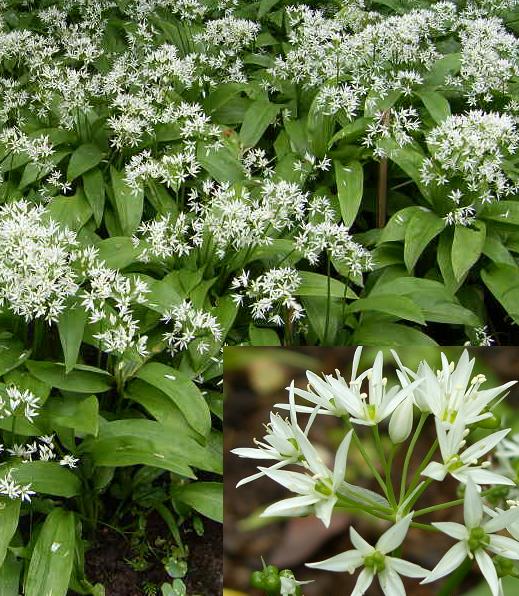RamsonsScientific Name: Allium ursinum |
Ramsons is a bulbous perennial in the Alliaceae Family, common to damp woodlands and hedge banks. It is said that bears awakening from hibernation eat it to cleanse their metabolism and regain their strength leading to one of the common names, Bear's Garlic, and the species name derived from the Latin for bear.
It is also called Wild Garlic but, in North America this can refer to Wild Onion (Allium canadense) with narrow flat leaves or another relative, Field Garlic (A. vineale) with round, hollow leaves, very unlike those of Ramsons. In some places Three-cornered Leek is called Wild Garlic.
The broad, bright green leaves start into growth in spring and flop over at their widest point. They have a characteristic garlic smell, so should easily be distinguished from similarly shaped leaves of Lily-of-the-Valley (Convallaria majalis), Autumn Crocus (Colchicum autumnale), both of which are toxic. As the flowers mature the leaves begin to fade.
Between April and June the flowers appear. They are white and star-like in a broad umbel on a leafless stalk and are normally self-pollinated. Later a seed pod replaces each flower, as they mature the seeds turn black and show through the outer skin as it becomes transparent.
All parts of the plant are edible and can be eaten raw or cooked (some recipes below). Ramsons also has great health giving properties and is said to be more potent than cultivated garlic, A. sativum, in this respect. It has antioxidant properties which reduce blood pressure and cholesterol levels, and the juice has antiseptic properties. The active ingredients are more concentrated in the leaves. There are many sulphur compounds - Allicin is named as the main beneficial one and also gives it the typical odour.
The leaves are gathered in the spring before the flowers open and can be made into a pesto, eaten in sandwiches or chopped and used as a garnish in salads, soups or in mashed potato. The elongated bulbs can be harvested in the autumn for use like cultivated garlic.
Given all the health and culinary benefits it may not be unwanted, but if it has become invasive removal is necessary, digging it up is not usually successful as there are many bulblets and seeds. Over a number of years, continual cutting should eventually exhaust the bulbs and the reservoir of seeds.
A systemic weedkiller such as Glyphosate applied in the spring when the leaves are actively growing, should eradicate it. A selective agent will also be effective and is useful for the N. American relatives mentioned above, which tend to invade grassed areas. Re-treatment will be necessary due to the reservoir of seeds.
See also Three-cornered Leek, which has a similar odour and flowers, and is just as invasive invasive.
Recipes
Wild Garlic Soup:
•1 chopped onion
•1 tbsp any vegetable oil
•250g potatoes, scrubbed and cubed
•125g wild garlic leaves, washed and roughly chopped
•1 litre vegetable stock
•squirt of lemon
•salt & freshly ground black pepper
1.In a large saucepan, sweat the onion in a saucepan in the oil for about 10 minutes, until soft, add the cubed potatoes and quickly stir-fry. Add the stock and simmer until the potatoes are just soft.
2.Add the wild garlic, cover and simmer for a couple of minutes until cooked, but are still a vibrant green colour. Either serve as is or liquidise.
3.Season with salt and pepper and add a squirt of lemon juice.
Serves 4.
Wild Garlic Pesto:
A large bunch, washed wild garlic
A small bunch, washed parsley
60g toasted pine nuts
60g Parmesan
150ml of olive oil
squirt of lemon juice
salt and black pepper
Either mash in a mortar and pestle after chopping the ingredients or blitz in a blender while slowly adding the olive oil.
